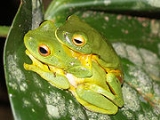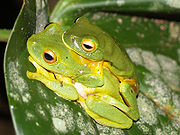
Amplexus
Encyclopedia

Pseudocopulation
Pseudocopulation describes behaviors similar to copulation that serve a reproductive function for one or both participants but do not involve actual sexual union between the individuals. It is most generally applied to a pollinator attempting to copulate with a flower. Some flowers mimic a...
in which a male amphibian
Amphibian
Amphibians , are a class of vertebrate animals including animals such as toads, frogs, caecilians, and salamanders. They are characterized as non-amniote ectothermic tetrapods...
grasps a female with his front legs as part of the mating process. At the same time or with some time delay, he fertilizes the female eggs with fluid containing sperm
Spermatozoon
A spermatozoon is a motile sperm cell, or moving form of the haploid cell that is the male gamete. A spermatozoon joins an ovum to form a zygote...
.
Amplexus chiefly occurs aquatically, but some more terrestrial anurans like the disc-tongued frogs (Discoglossidae
Discoglossidae
Discoglossidae is a family of primitive frogs, with the common name Disc-Tongued Frogs. Most are endemic to Europe, but there are also three species in North-West Africa, and an extinct species formerly occurred in Israel....
) perform amplexus on land. In more advanced anurans like the true frogs (Ranidae), the tree frog
Tree frog
Hylidae is a wide-ranging family of frogs commonly referred to as "tree frogs and their allies". However, the hylids include a diversity of frog species, many of which do not live in trees, but are terrestrial or semi-aquatic.-Characteristics:...
s (Hylidae) and the true toads (Bufonidae) the amplexus is axillary (in the armpits), while in less derived anurans (the Archaeobatrachia
Archaeobatrachia
Archaeobatrachia is a suborder of Anura containing various primitive frogs and toads. As the name literally suggests, these are the most primitive frogs. Many of the species show certain physiological characteristics which are not present in other frogs and toads, thus giving rise to this group...
) and frogs in the Myobatrachidae
Myobatrachidae
Myobatrachidae is a family of frogs found in Australia and New Guinea. Members of this family vary greatly in size, from species less than long, to the second largest frog in Australia, the Giant Barred Frog , at in length...
family it is lumbar (abdominal, in front of the hindlegs). The Sooglossidae
Sooglossidae
The Seychelles Frogs are a family of frogs found on the Seychelles Islands and India. Until recently this family was believed to include the genera Nesomantis and Sooglossus, but following a major revision of amphibians in 2006 the genus Nesomantis was named a junior synonym of Sooglossus;...
show inguinal amplexus where the male holds the female at the waist just anterior to her hind legs. Some species show cephalic amplexus where the head of the female is held while others show complete lack of amplexus.
In most anurans the males deposit sperm onto the eggs as they are being laid, however males of the genus Ascaphus possess an intromittent organ, unique among anurans, for internal fertilization. Internal fertilization does occur in a few other genera, including Nectophrynoides
Nectophrynoides
Nectophrynoides is a genus of true toads endemic to Tanzania. Some species in it have a most unusual reproductive feature. Species of the group are viviparous: fertilization is internal, and the females give live birth. They are the only toads in the world that do not lay eggs. They also do not...
, Mertensophryne
Mertensophryne
Mertensophryne or "Snouted Frogs" is a genus of true toads native to Eastern and southern Democratic Republic of Congo to Kenya, Tanzania, Malawi, southeastern Zimbabwe and adjacent Mozambique...
, and Eleutherodactylus
Eleutherodactylus
Eleutherodactylus is a genus of frogs in the Leptodactylidae family. It is typically described as the largest vertebrate genus on Earth, with over 700 species...
.
Newts
In the case of newtNewt
A newt is an aquatic amphibian of the family Salamandridae, although not all aquatic salamanders are considered newts. Newts are classified in the subfamily Pleurodelinae of the family Salamandridae, and are found in North America, Europe and Asia...
s the process of amplexus is often observed soon after the newts become seasonally active. In the western USA, for example, this time is typically soon after the onset of the winter rainy season, when intermittent streams and vernal pools become available as breeding habitat. The Rough-skinned Newt
Rough-skinned Newt
The rough-skinned newt is a North American newt known for its strong poison.- Toxicity :Many newts produce toxins to avoid predation, but the toxins of the genus Taricha are particularly potent...
is a specific widespread example of a newt in the western USA that can be observed in quiet stream pools and shallow ponds engaging in amplexus.


